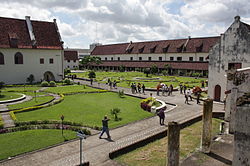Brazil

This is a list for articles on notable historical forts which may or may not be under current active use by a military. There are also many towns named after a Fort, the largest being Fort Worth, Texas, United States.
Antwerp (historical) (1914, internal defenses)
Namur (1914, clockwise from E, right bank of Meuse River)
Bermuda had around 90 coastal defense forts and batteries [1] scattered all over the island chain. Early colonial defense works constructed before the 19th century were primarily small coastal batteries built of stone having anywhere from two to ten guns. Some of these early forts and batteries are the oldest standing masonry forts in the new world. Later forts constructed by the royal engineers were much larger and more complex.

Many buildings and structures bear the name fort in Canada. Most of these places are either military installations, or a trading post that was established by a North American fur trading company. A number of "forts" in northern and western Canada were also established as exploratory, or policing outposts.
A number of municipalities in Canada include the term fort in their names. The municipalities that use the term fort in their name do so for historical reasons, with many of these communities resulting from the outgrowth of migrants that settled around the original fort. Many of these municipalities continue to bear use the term fort in their names, regardless of whether or not the original fortification and/or trading post still stands.
The majority of military fortifications in Canada were built by the British, French, and Canadian armed forces. However, several military fortifications were erected by the Hudson's Bay Company, whose royal charter required them to fortify Rupert's Land. Other groups that erected military fortifications in Canada includes First Nations, Spain, and the United States. Although military fortifications were built for strategic, and other military purposes, some military fortifications in Canada also housed trading posts, or was used by fur traders.
Several private entities, most notably the Hudson's Bay Company, established outposts or forts, within northern Canada for the purposes of housing exploratory expeditions to the Arctic. Forts that were built exclusively for the purposes of housing exploratory expeditions include:
A number of trading posts operated by fur trading companies were also referred to as forts. Fur trading companies that operated trading forts in Canada includes the Hudson's Bay Company, and the North West Company. Many of these were simply stockades, log enclosures for trading posts, although a few were former military installations which was later used by fur trading companies.
The North-West Mounted Police (later merged with the Dominion Police to form the Royal Canadian Mounted Police) established a number of policing outposts in western Canada during the mid to late 19th century, in an effort to provide law enforcement in the region. Forts established by the North-West Mounted Police includes:
All forts in Macau were built during or used during Portuguese rule:

Kaunas Fortress fortifications (listed in order of number)


See also the list of castles, as many early forts were called castles, and many castle sites were reused for later fortifications. Also Palmerston Forts lists the many British fortifications built in the 1860s.





